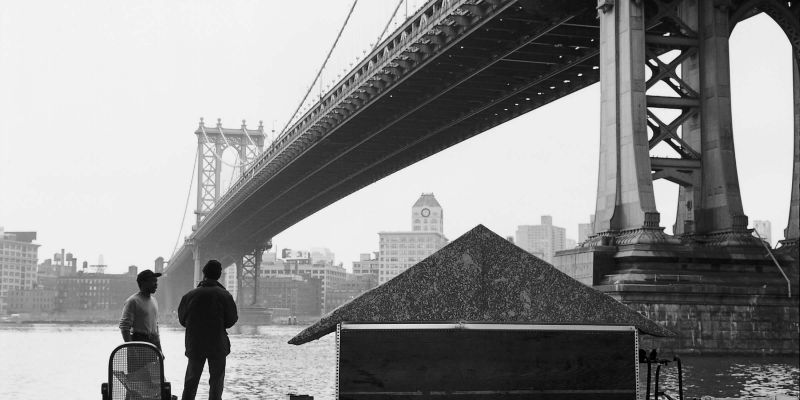Margaret Morton’s Decade with the Homeless at Leica Gallery
In 1989, when Margaret Morton was teaching at The Cooper Union and living nearby in the East Village, her walk to work took her past Tompkins Square Park, where an encampment of people living in improvised structures had grown into a national symbol of the ongoing homeless crisis. Morton found herself attracted to the shelters themselves, rough collections of scavenged materials that served as protection from the environment for people living in the park, and she began photographing the dwellings with permission from their residents. Her handsome black and white photos from the era show enclosures made from plastic sheeting and cardboard, sometimes covered with signs and messages.
As she worked, Morton became increasingly interested in the people themselves. After police destroyed the encampment later that year, Morton stayed in touch with her contacts as they scattered throughout the city, and began photographing them with the new homes they built and the gardens the planted in empty lots. It was the beginning of close to a decade of work documenting a series of ad hoc communities throughout New York that produced four books and countless shows. In the process, Morton recorded evidence of universal ideas about the notion of home, visible in the elaborately adorned structures her subjects built. “The care that is evident in these homes and their gardens goes far beyond a basic need for shelter and security and reflects the profound human need that we all share to personalize, to decorate, to collect, and to display,” Morton tells New York Photography Diary. She thought the work might help change the conversation about homelessness. “It was my hope that people would not look down on homeless men and women if I could share how hard they were working to create a sense of home,” she says. The work here, shown together for the first time (and up until August 15 at Leica Gallery), suggests a single, expansive project documenting a variety of responses to the question of home from those on the edges of society.
As a photographer trained in the tradition of Walker Evans, Morton was attuned to meaning found in the social landscape. She received her MFA from Yale where Evans famously taught for ten years, and although he died shortly before she arrived, his lyrical approach to documenting American culture continued to influence the department. The style fit Morton’s focus on both her subjects and the objects they built—she photographed tiny houses with courtyards and front porches, built from salvaged palettes, as well as the elderly Puerto Rican men who made them and lived in them. Her portraits show men and women at ease in their surroundings—a man cooks ‘tunnel stew’ over an open flame in the rail tunnels that run under the Upper West Side and Harlem, where Morton photographed in the early 1990s. Another lounges by the pond he built in an empty lot, which he occasionally stocked with goldfish. Behind him grow the corn and tomatoes he planted for food.
Morton’s images serve as documents of her subjects’ lives, but they also find moments of beauty. While photographing in the tunnels, Morton was struck by the shafts of light that stream down through the sidewalk grates—the vast, illuminated space she recorded resembles a cathedral. Morton recalled asking former a resident of the tunnel if there was anything she ever missed about her grim existence there— the woman remembered the power of that space when she was depressed. “I would just stand there, in that single beam, and bathe myself in light,” she told Morton. This show brings together a decade’s worth of these small moments of grace in difficult lives.
 Rebecca Robertson is co-editor of New York Photography Diary. She is a freelance writer, curator and photo editor in Queens. She studied photography and art history at Bryn Mawr College and received her MFA in photography and related media from the School of Visual Arts. She has worked in the New York art world for more than 10 years. She has written about photography for ARTnews magazine and curated shows, most recently a series of benefit exhibitions for UNICEF.
Rebecca Robertson is co-editor of New York Photography Diary. She is a freelance writer, curator and photo editor in Queens. She studied photography and art history at Bryn Mawr College and received her MFA in photography and related media from the School of Visual Arts. She has worked in the New York art world for more than 10 years. She has written about photography for ARTnews magazine and curated shows, most recently a series of benefit exhibitions for UNICEF.




